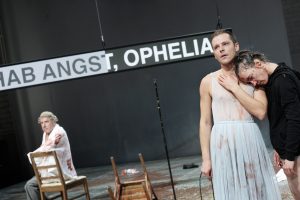Christopher Rüping‘s distillation of Shakespeare’s most famous play places Hamlet in the here and now. His story is told by three Horatios, who take over all the parts in this heavily cut production.

Courtesy of Thomas Aurin.
Set in an industrial warehouse, the royal court of Denmark is placed on a platform with a floor of steel grating. The only props are a few chairs and a conference table (stage design by Ramona Rauchbach). The musician Christoph Hart is providing an ominous musical score whilst the three actors carry in buckets filled with fake blood that is poured all over the floor. A digital display panel features the names of all the characters that are killed in the course of the play as they are crossed out one by one. Next, confetti is sprayed over the stage which is now wet with blood. Hamlet’s last words are displayed in their German translation: “Horatio! O, I die, Horatio. So tell them, with th’ occurrents, more and less,Which have solicited”.
The end is the beginning in Rüping’s take on Hamlet. All the principal characters are dead. Only Horatio remains to tell Hamlet’s story- as Hamlet’s disciple who ensures his master’s immortality. His memories are all that remain of the Danish prince. But how does a modern day Horatio remember Hamlet?
Unlike other productions that present Hamlet as a sensitive intellectual prince who struggles with his murdered father’s demand for revenge, Rüping’s sees Hamlet as a relentless narcissist and fanatic. Convinced that Elsinore is rotten to the core, Hamlet sees himself as the chosen one in a holy war. To the director, Hamlet is not a victim, he is a perpetrator running amok and thereby causing the death of many innocent people before he even gets to Claudius, the real culprit who murdered his father and committed incest by marrying his mother. Hamlet turns Elsinore into a slaughterhouse.
Christopher Rüping uses three Horatios to tell Hamlet’s story: Katja Bürkle, Nils Kahnwald and Walter Hess, who play all the characters of the drama, signified by a quick costume change. Whoever dons the black hoodie plays the Danish prince. Ophelia is represented by a transparent light blue dress. Claudius is in a dressing gown, Hamlet’s ghost is hidden under a bloody sheet.
The production focuses on a few key scenes to distil the essence of the play whilst important quotes are shown on the display panel. Katja Bürkle’s Hamlet swears his friend Horacio (Walter Hess) to secrecy by putting a finger in his mouth after encountering his father’s ghost, which can be seen as a display of power as well as of intimacy. Kahnwald then changes into Ophelia’s skimpy dress, a costume which is a sign of the character’s lack of power, to report on her relationship with Hamlet to her father Polonius. The fact that a man plays Ophelia makes the fragility and helplessness of this very weak female character become even more apparent. Katja Bürkle’s Hamlet brutally destroys Ophelia’s spirit in the very intense “get thee to a nunnery” scene. When Gertrude (Walter Hess) describes Ophelia’s suicide whilst confetti is raining down on the dead girl, clad in a soaked white dress covered in blood, and Hamlet (Katja Bürkle) cries bitter tears, the production achieves a very beautiful and truly poetic scene.
There is also some humour in the production. When the time for the most famous monologue of the play has come, none of the actors is willing to speak it. They exit and leave the musician to finally put on the hoodie and play recordings of famous German and English actors saying the first lines of “To be or not to be”. But the words keep on appearing on the display panel, leading up to the final scene and the deadly duel between Hamlet and Laertes. At this point many buckets of fake blood are poured out over the actors, which prompted some of the older members of the audience to leave the auditiorium.
Christopher Rüping’s Hamlet celebrates its actors as they switch between their different characters and use their projection skills to full effect. Katja Bürkle is one the toughest, most relentless Hamlets ever seen on stage and no Ophelia has ever appeared more vulnerable as in Nils Kahnwald’s performance. Walter Hess is an outstanding narrator and makes quite an impact as Gertrude in a costume emulating Queen Elizabeth I. A bold interpretation with an outstanding cast. 4/5
Review written by Carolin Kopplin
Hamlet will next be shown on Wednesday 20th June 2018. For further info, click here…
The production is in German without surtitles.


Leave a Comment